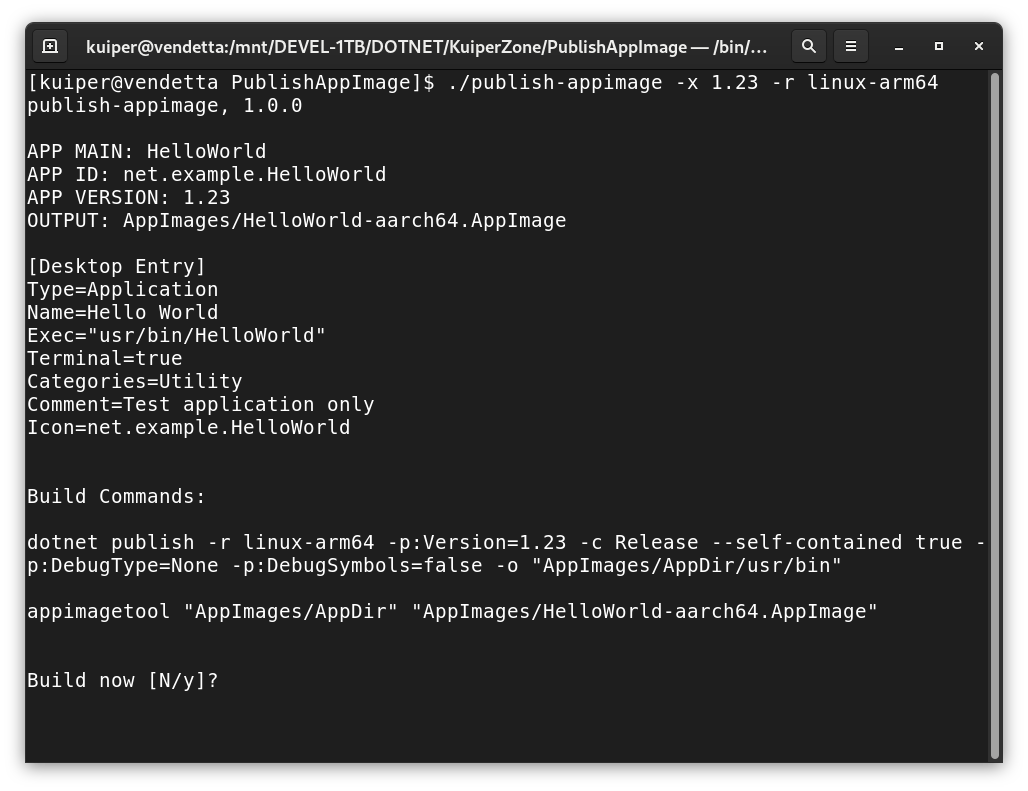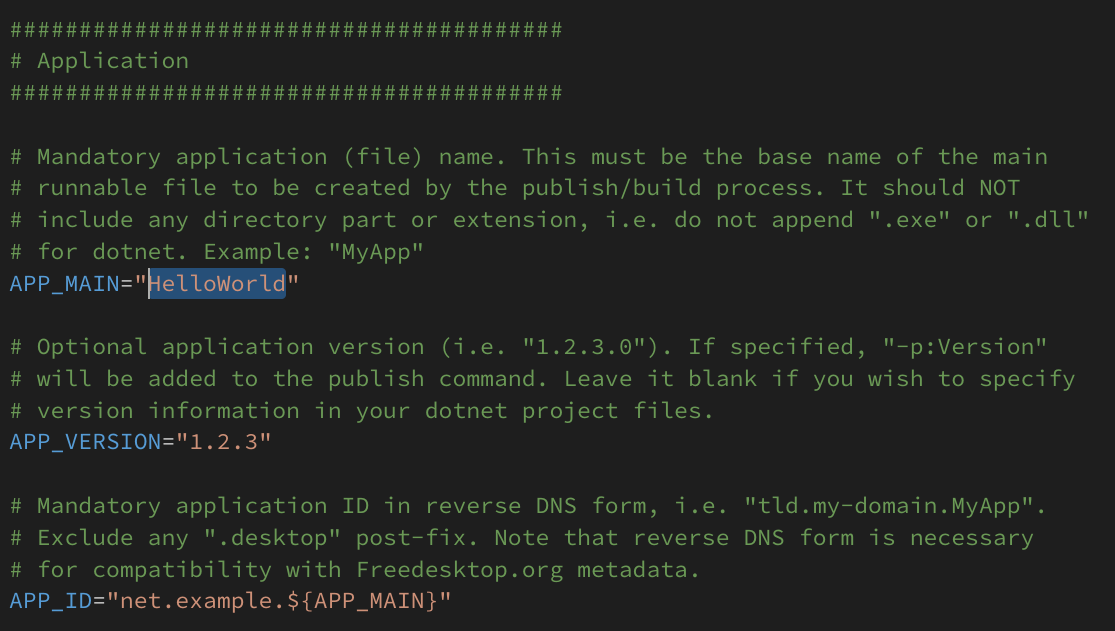Publish-AppImage for .NET is a simple bash script deployment utility which calls dotnet publish and
packages the output as an AppImage file (or zip) with a single command.
Publish-AppImage for .NET for has been superseded by Pupnet Deploy:
https://github.com/kuiperzone/PupNet-Deploy
Unlike Publish-AppImage, PupNet not only builds AppImages, but Windows Setup files, Flatpaks, Debs and RPMs.
To use Publish-AppImage, you fill out the option fields in a simple configuration file called publish-appimage.conf, and run:
./publish-appimage
This builds/publishes your project and generates a distributable AppImage output file for use on Linux systems.
A Linux "Desktop Entry" file is generated automagically from the values provided by you in the configuration file.
Additionally, Freedesktop.org AppStream metadata (appdata.xml) is optionally supported. Detailed explanations, examples
and a demo application are provided below.
Publish-AppImage for .NET is licensed under MIT and is for use on Linux with the Microsoft .NET SDK (i.e. for C# applications).
Publish-AppImage for .NET requires (*):
- Bash shell
- .NET SDK 5.0 or later
- The appimagetool utility to build the AppImage file
- The Linux "zip" utility is optional and typically may already be installed on your system
(*) Tested bash 4.4.20 and appimagetool r13 (31 Dec 2020).
A simple "HelloWorld" terminal demo application is provided with the script and the configuration (.conf) file.
You may use the .conf and appdata.xml files contained in this demo as templates for your own application.
Let's start by building and running the "HelloWorld" demo. Clone or download the entire project, and follow the instructions below.
IMPORTANT: Download and install appimagetool. Ensure that appimagetool
is in the path, or you can specify its location in the .conf file if you have downloaded it as an AppImage file.
For example, in publish-appimage.conf, change this line:
APPIMAGETOOL_COMMAND="appimagetool"
to this as appropriate:
APPIMAGETOOL_COMMAND="/home/user/Apps/appimagetool-x86_64.AppImage"
The publish-appimage file itself is just a bash script so there is no need to "build" it, but ensure that it
has the executable flag set. From the top-level project (the same directory as the .conf file), simply type:
./publish-appimage
This will call dot publish (with "linux-x64 as default) and create an output directory local to the .conf file,
i.e.: AppImages/HelloWorld-x86_64.AppImage
If your system is ARM, type this instead:
./publish-appimage -r linux-arm64
Run AppImages/HelloWorld-x86_64.AppImage (or the arch64 variant) from a terminal, and it will output version
and location information available to the application. That's all it does!
There are only two files you really need (although you may wish to use an appdata.xml file). Drop the files,
below, into your application source preferably at the same level as your solution (.sln) or project (.csproj) file (*).
publish-appimage- the utilitypublish-appimage.conf- your project config
Alternatively, if you wish, you may put the publish-appimage script in any directory on your system and add
its directory to your PATH. This way, only the ".conf file" need go into your project.
(*) If you do not wish to put publish-appimage.conf in the same directory as your .sln or .csproj, you can
specify the location with DOTNET_PROJECT_PATH in the .conf file.
IMPORTANT: By default, publish-appimage will look for a file called publish-appimage.conf in the current
working directly. However, it is entirely possible to have multiple .conf files of different names in the same
directory. You are not restricted to a single conf file in your project! See the "--conf" command option described
below.
Now edit the configuration file for your own application, providing an application name etc. This should be a relatively trivial matter and all parameters are documented with comments. You can specify application "Desktop Entry" fields here, as well as publish/build arguments, along with project and output locations. Note that all project related paths in the .conf file itself are relative to the location of the .conf file, and not from where command was called.
If you wish to use a Freedesktop.org metadata file, copy the "Hello World" appdata.xml file from the "Assets"
directory and use it as a template in your project, changing or adding properties to suit. Ensure that your
publish-appimage.conf correctly references the file location using APP_XML_SRC. If you do not wish to use
appdata.xml, ensure that APP_XML_SRC is unset.
Ensure also that your publish-appimage.conf references an icon file location using APP_ICON_SRC,
as this is a mandatory requirement.
Use the APP_VERSION parameter in the .conf file to specify your application version, i.e. "1.2.3.0".
This will call dotnet publish with the -p:Version option (overriding any version value in your project files)
and sets the VERSION environment variable for use by appimagetool. In the .conf file, you may optionally version
the output package filename with PKG_VERSION_FLAG.
Alternatively, leave APP_VERSION unset to prefer application version information already provided in your project.
The configuration contains an option called POST_PUBLISH. This may contain one or more commands, or point to a
script file for example. It is called after dotnet publish, but before the final AppImage output. You can use this
to create required directory structures under AppDir or copy additional files there.
See also "Non-.NET Projects", below.
By default, publish-appimage will build for "linux-x64". However, you can specify the dotnet "runtime identifier" as:
./publish-appimage -r linux-arm64
For information, see: https://docs.microsoft.com/en-us/dotnet/core/rid-catalog
By default, publish-appimage looks for a single file called publish-appimage.conf. However, your
application project may contain multiple .conf files, but you must specify the configuration to use at
the command line, like so:
./publish-appimage -f other-file.conf
Amazingly, it is possible to build for Windows on a Linux box, although the binary is not suitable for use with the AppImage format. However, you can do this instead:
./publish-appimage -r win-x64 -k zip
This will create a simple zip file of the published content instead of an AppImage file.
Usage:
publish-appimage [-flags] [-option-n value-n]
Help Options:
-h, --help
Show help information flag.
-v, --version
Show version information flag.
Build Options:
-f, --conf value
Specifies the conf file. Defaults to publish-appimage.conf.
-r, --runtime value
Dotnet publish runtime identifier. Valid examples include:
linux-x64 and linux-arm64. Default is linux-x64 if unspecified.
See also: https://docs.microsoft.com/en-us/dotnet/core/rid-catalog
-k, --kind value
Package output kind. Value must be one of: appimage or zip.
Default is appimage if unspecified.
-b, --verbose
Verbose review info output flag.
-u, --run
Run the application after successful build flag.
-y, --skip-yes
Skip confirmation prompt flag (assumes yes).
-o, --output
Explicit final output filename (excluding directory part).
Publish-AppImage for .NET was created by Andy Thomas at https://kuiper.zone
See also my other C# project, a cross-platform Avalonia XAML previewer called AvantGarde.
The appimagetool validates the application metadata file (appdata.xml) prior to generating the AppImage output.
However, validation appears to be somewhat pedantic and may cause problems. In this case, you may leave the
APP_XML_SRC configuration option empty to omit metadata. See also the following for clues and leads in problem
solving: AppImage/AppImageKit#603
If you are using VirtualBox with your project within a shared folder, note that symbolic links are disabled within
shared folders by VirtualBox, and this will prevent appimagetool from working. To overcome this, copy
your entire project to your home directory in the virtual machine. Alternatively, it is possible to enable shared-folder
symlinks in VirtualBox.
It is also possible to use Publish-AppImage to build non-.NET projects (i.e. C++), although I don't imagine
this will be a primary use case. To do this, you must use a suitable build script and specify the file
location using the POST_PUBLISH config parameter. Your build script must populate the directory AppDir/usr/bin.
You should also set DOTNET_PROJECT_PATH="null" in order to disable the dotnet publish operation.
You may wish to consider adding your output directory (i.e. "AppImages") to your gitignore file.
I initially intended that this utility spit out Flatpaks as well as AppImages. However, the configuration and building of Flatpaks adds complexity. For the moment, I decided that this project was best served by keeping things simple and elegant. I may do something on this a later, however.
Don't forget to like (star) and share this project (but only if you do like it of course).


